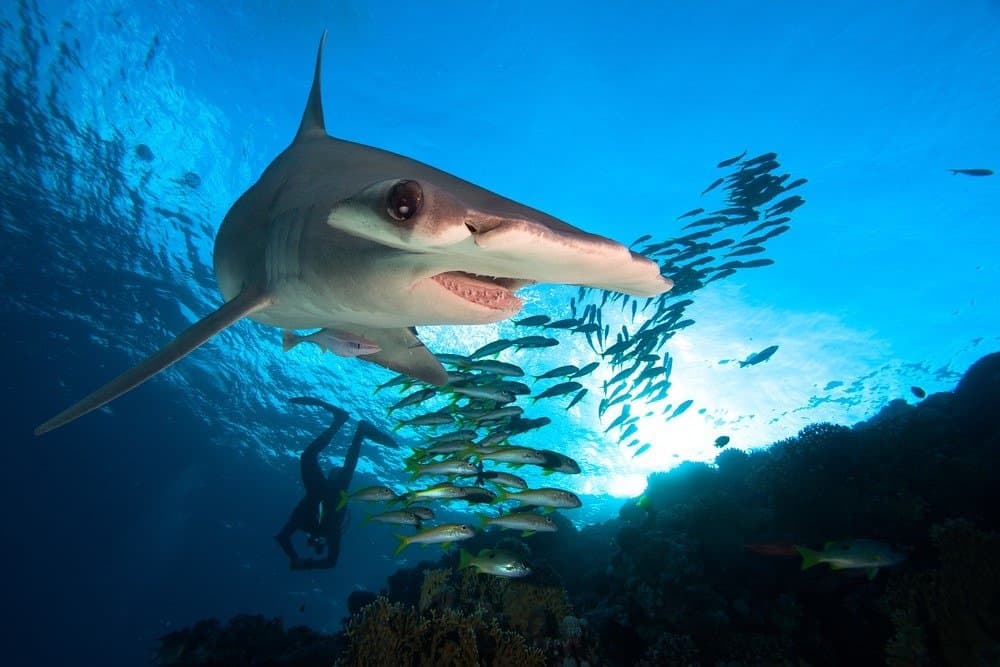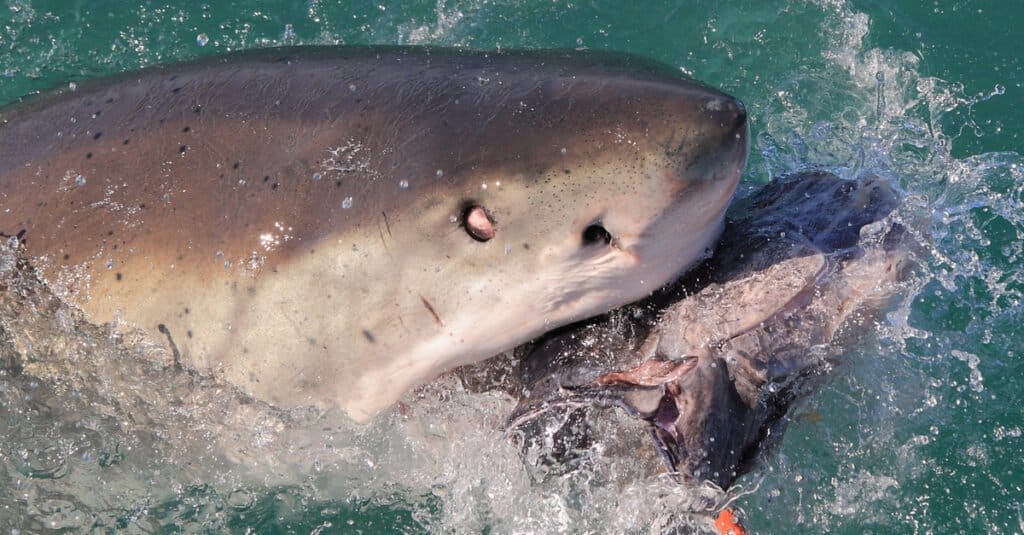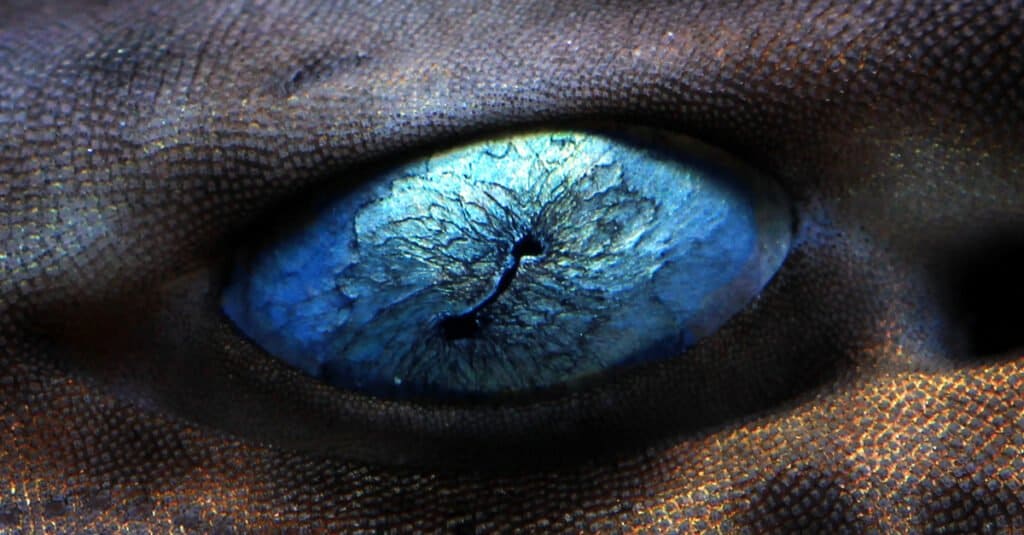Instead of watching cat videos, if you have some downtime, you should watch a slow-mo video of a gecko licking its eyeball. Fascinating! Geckos do not have eyelids, but need to keep their eyeballs moist and clean, so a quick lick from their tongue does the trick. Most fish do not have eyelids because they are essentially swimming around in a world of saline solution. There is no need for them to keep their eyeballs moist because they are in the water. So, what about sharks, do they have eyelids?
Yes! Sharks have eyelids that are more for protection than for keeping their eyes moist. There are two main eyelid structures for sharks, some have eyelids that close when needed during feeding and fighting and others have a third eyelid called a nictitating membrane which is clear and slides down over the eyeball for protection. Some believe the membrane may also serve as a type of reading glasses (not for reading of course, but to help the shark focus). Let’s take a look at shark eyelids!
Shark Eyelids: How does a nictitating membrane work?

Nictating membranes protect the eyes of sharks.
©frantisekhojdysz/Shutterstock.com
The third eyelid – as it is called – can slide down to protect a shark’s eye. These types of eyelids are found in other animals as well. Camels are mammals that have a nictitating membrane to protect their eyes from the sand and debris in the dessert. Snakes have one as well and use it to protect their eyes when slithering so close to all the dirt on the ground. Birds like owls and eagles have a nictitating membrane as well which automatically covers their eye when they need to fly at high speeds and to help their vision so they can locate prey far below. Frogs have one that they use like swim goggles! When they jump into the water the nictitating membrane covers their eyes and helps them see better underwater!
Sharks that have a nictitating membrane:
- Most shark species
- Tiger sharks
- Hammerhead sharks
Sharks that do not have a nictitating membrane:
- Great white
- Shortfin mako
- Thresher
- Sand Tiger
- Dogfish
- Basking
How do sharks without a nictitating membrane protect their eyes?

Great whites
roll their eyes backward into their heads to protect their eyes.
©Alessandro De Maddalena/Shutterstock.com
So, what do sharks do that don’t have the nictitating membrane? All sharks do have eyelids, but they don’t come together to cover the eye completely. They have an upper eyelid and a lower eyelid that can close, but not all the way. For the above-mentioned sharks, that is where the nictitating membrane comes in to help but what about the sharks that don’t have the third eyelid? They posses an adaptation that allows them to roll their eyes backward into their head! Crazy right? A strong membrane is pulled up over the eye socket to protect the back of the eye.
There are videos of Great White sharks doing this during a fight with a prey. When they attack animals like seals and sea lions they are often met with sharp claws and teeth when they fight back and sharks need a way to protect their vision.
What are shark eyes like?

Shark eyes have a number of appearances.
©Kurit afshen/Shutterstock.com
A shark’s eye is similar to a human in that it has a pupil that reacts to movement (even while it sleeps) and has a cornea, iris, retina and lens. Some shark eyes have a vertical pupil like the sandbar shark and others have a round pupil like the sand tiger shark. Both of these sharks have a yellowish eye with a black pupil but some sharks like the Mako have one large black eye. Blue sharks have a white ring around their eyes.
Shark’s eyes are similar to cats in that they have a tapetum lucidum at the back of their eye which is a mirror like membrane that acts to increase light coming in to help the shark see in varying lighting. It was once thought that sharks could see in color but more recent studies have found that it is likely that they do not. But they do have good vision and can see very well and use their vision for help in hunting.
Do sharks only rely on their vision for hunting?
No, sharks do rely on vision for hinting but they also use an amazing sense of smell (being able to smell a drop of blood from a quarter mile away!). They also use electroreception to locate prey, they can detect electrical currents from other sea animals and use this to find them and attack.
Do whales have eyelids?
Yes! Whales have eyelids that are more similar to human eyelids however they are quite thick and more difficult to close. Whales do not need to blink to keep their eyes moist and they don’t need to blink to keep their eyes clean, but they do close them on occasion spreading a jelly-like substance over them for protection.
Do sharks close their eyes when they sleep?
No, which is kind of freaky. Some sharks have large black eyes that seem to go straight to their soul and they never close them to sleep! Whales and sharks have the ability to shut down one side of their brain while sleeping, keeping the other side alert and active. Sharks will keep their eyes open even when sleeping while whales on the other hand will close one of their eyes and literally sleep with “one eye open.” Sperm whales, which have really large eyelids, actually move their eyeballs inward when the lid closes!
A fun fact on octopus eyes
Octopus have eyelids that are ring-shaped and protect their eyes. One research group found that although they are though to be color blind, their pupils may be able to detect color. After all they are able to change color to adapt to their surrounding and to camouflage themselves (and to impress their date). How can they do these things and be color blind? More research is obviously needed!
The photo featured at the top of this post is © Kurit afshen/Shutterstock.com
Thank you for reading! Have some feedback for us? Contact the AZ Animals editorial team.






